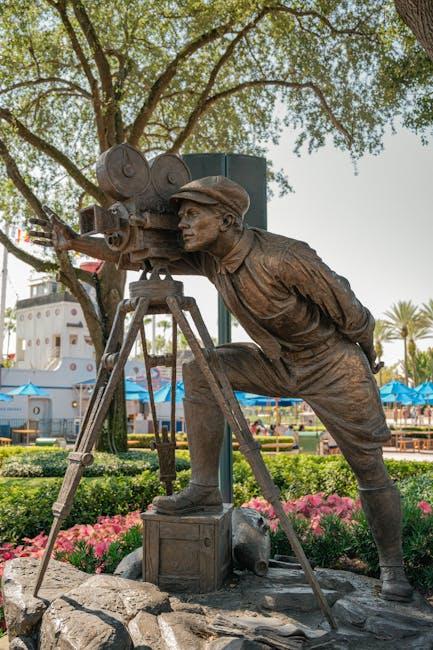In the dim glow of a theater, as the opening scenes unfold, audiences are often drawn into worlds crafted not just by dialogue and action, but by the subtle dance of symbols woven into the narrative. From a solitary rose resting on a windowsill to the persistent ticking of a clock, directors wield symbolism as a powerful tool, enriching the tapestry of storytelling with layers of meaning and emotion. These visual and auditory cues invite viewers to delve deeper, to uncover hidden truths and emotions that transcend the spoken word. This article explores the nuanced art of symbolism in film, revealing how directors masterfully embed these elements to enhance and elevate the stories they tell.
Crafting Visual Metaphors: The Art of Symbolism in Film
In the realm of cinema, directors wield visual metaphors as powerful tools to transcend mere dialogue, imbuing their stories with layers of meaning. Through symbolism, filmmakers can subtly guide audiences to uncover deeper truths within the narrative. For instance, the recurring motif of mirrors can reflect themes of duality or self-examination, while the presence of birds might symbolize freedom or foreboding.
- Colors: Directors often employ color palettes to evoke emotions or signal transitions. A shift from warm tones to cold hues can suggest a change in mood or fortune.
- Objects: Everyday items, like a spinning top or a red balloon, can become powerful symbols, representing concepts such as reality versus illusion or innocence lost.
- Lighting: The interplay of light and shadow can highlight the internal conflict of a character, with stark contrasts often used to depict moral ambiguity.
By crafting these visual metaphors, directors invite viewers to engage with the film on a more intuitive level, encouraging them to explore the intricate dance between what is seen and what is meant.

Subtle Signals: How Symbolism Speaks to the Subconscious
Directors often weave a tapestry of symbolism into their films, allowing them to communicate complex themes and emotions without overt exposition. These subtle signals can guide audiences to a deeper understanding of the narrative, engaging the subconscious mind in a dialogue beyond the spoken word. Consider how color palettes are used: a recurring hue might suggest a character’s emotional journey or the presence of an unseen force. The repetition of certain objects, like a clock or a key, can hint at themes of time, destiny, or unlocking hidden truths.
- Color: Often used to represent emotions or foreshadow events.
- Objects: A recurring motif that can symbolize broader themes.
- Animals: Can embody character traits or serve as omens.
Through these techniques, directors craft layers of meaning that resonate on an instinctual level, enriching the viewer’s experience and inviting them to explore the story’s deeper implications. Such artistic choices invite audiences to become active participants in the storytelling process, piecing together the puzzle of the narrative through intuitive recognition of these symbolic cues.

Color and Composition: Using Visual Elements to Deepen Narrative
In the realm of cinema, color and composition serve as powerful tools to subtly weave deeper meanings into a narrative. Directors meticulously select color palettes to evoke emotions and symbolize themes. For instance, Wes Anderson often employs pastel tones to create whimsical worlds, while Christopher Nolan uses stark contrasts to highlight moral ambiguity. These choices are not merely aesthetic; they are deliberate strategies to immerse audiences in the story’s emotional core.
Beyond color, the composition of a scene—the arrangement of elements within the frame—can dramatically influence storytelling. Consider the following techniques used by directors to enhance narrative depth:
- Symmetry and Balance: Often used to convey harmony or control, as seen in Stanley Kubrick’s precise framing.
- Asymmetry: Creates tension or highlights chaos, a favorite of directors like David Fincher.
- Foreground and Background Contrast: Directs attention and establishes relationships between characters and their environments.
By intertwining these visual elements, filmmakers craft a richer, more engaging narrative tapestry that resonates on both a conscious and subconscious level.

Symbolic Objects: Infusing Meaning into Everyday Items
In the realm of cinema, directors often weave layers of meaning into their narratives by utilizing everyday objects as potent symbols. These symbolic objects serve as visual metaphors, enriching the storyline and deepening the audience’s emotional connection. A seemingly mundane item can transform into a powerful narrative device, echoing themes and character arcs. For instance, a broken watch might signify lost time or missed opportunities, while a simple red balloon could embody innocence or fleeting happiness.
- Colors: Colors can infuse objects with mood and emotion, guiding the viewer’s subconscious interpretations.
- Repetition: Repeated appearances of an object can underscore its significance, subtly reminding the audience of its thematic weight.
- Juxtaposition: Placing symbolic objects in contrasting contexts can highlight conflicts or dualities within the narrative.
By skillfully integrating these elements, directors craft a rich tapestry of meaning, turning the ordinary into the extraordinary, and inviting viewers to explore the deeper layers of the story.

